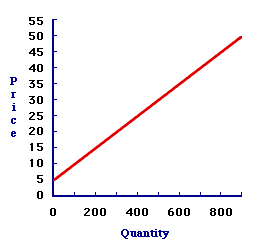
|
|
RULE OF CONSUMER EQUILIBRIUM: A condition of consumer equilibrium and utility maximization stating that the marginal utility-price ratio for all goods are equal. This rule is a handy way of checking for consumer equilibrium and utility maximization. If the rule is not satisfied, then consumer equilibrium and utility maximization are not achieved.
Visit the GLOSS*arama
|
|


|

|
                           SUPPLY PRICE: The minimum price that sellers are willing and able to accept for a given quantity of a good. While sellers might be willing and able to accept more than the supply price for a given quantity, they are not willing and able to accept less. The supply curve is a plot of the supply price for each quantity. Supply price is the lowest price that sellers will accept for a good. It is based on the opportunity cost that sellers incur in the production of the good. While a number a factors influence the supply price, quantity supplied tends to be among the most important. The supply price is generally higher if the quantity supplied is greater.Getting More For LessThis notion of supply price as a minimum comes from the fundamental economic observation that people prefer more to less. As a lower limit, supply price indicates that sellers are willing to accept more for a given quantity, but not less. By accepting more for one good, sellers have extra profit remaining after paying the opportunity cost of production.Consider the hot fudge sundae selling activities of the Hot Momma Fudge Bananarama Ice Cream Shoppe. Hot Momma Fudge is willing and able to accept $3 for a Hot Momma Fudge Bananarama Ice Cream Sundae. However, due to the opportunity cost of producing Hot Momma Fudge Bananarama Ice Cream Sundaes, Hot Momma is unable to accept a penny less than $3. But, Hot Momma would not complain if they could sell this tasty treat for $4. They would not argue if they could make the sale for $5. In fact, they are not likely to disagree if they found it possible to sell the sundae for a price of a hundred million dollars. The more they receive, the better. On the Supply Curve| Supply Price |  |
As the minimum price that sellers are willing and able to accept, the supply price lies ON the supply curve. In essence, the supply curve is the supply price. The supply curve plots the range of supply prices for a range of different quantities.Consider the supply curve for electronic calculators displayed in the exhibit to the right. For a quantity of 200 calculators, the supply price is $15. Would calculator sellers like to accept more than $15? Certainly. Would calculator sellers accept less than $15? No. The story is the same for any quantity. Only the numbers differ. For a quantity of 800 calculators, the supply price is $45. Sellers are willing to accept more than $45 for this quantity, but not less. A Lot of Supply SpaceThe area above the supply curve that includes all prices that sellers are willing to accept is termed the supply space. It includes all prices down to and on the supply curve. Buyers are willing and able to sell any price-quantity combination in this supply space.If sellers are able to operate above the supply curve, such that the price paid is more than the minimum supply price, then they obtain what is called producer surplus. This is the extra revenue received by sellers over and above the opportunity cost of production. And A Little CompetitionCompetition among sellers is the force that pushes the market price of a good down to the minimum supply price. This ensures efficiency, at least from the supply side of the market. With competition, sellers bid down the price until the minimum supply price is reached. If a seller is unwilling or unable to accept that price, then they do not sell the good. Moreover, buyers have no reason to buy from any sellers charging more, because competition ensures that other sellers are willing and able to charge the supply price.

Recommended Citation:SUPPLY PRICE, AmosWEB Encyclonomic WEB*pedia, http://www.AmosWEB.com, AmosWEB LLC, 2000-2025. [Accessed: July 1, 2025].
Check Out These Related Terms... | | | | | | | | | | |
Or For A Little Background... | | | | | | | | | | |
And For Further Study... | | | | | | | | | | | | |
Search Again?
Back to the WEB*pedia
|



|

|
BEIGE MUNDORTLE
[What's This?]
Today, you are likely to spend a great deal of time touring the new suburban shopping complex looking to buy either a genuine down-filled pillow or one of those "hang in there" kitty cat posters. Be on the lookout for defective microphones.
Your Complete Scope
This isn't me! What am I?
|

|
|
On a typical day, the United States Mint produces over $1 million worth of dimes.
|

|
|
"Experience keeps a dear school, but fools will learn in no other. " -- Benjamin Franklin
|

|
AIC
Akaike's Information Criterion
|

|
|
Tell us what you think about AmosWEB. Like what you see? Have suggestions for improvements? Let us know. Click the User Feedback link.
User Feedback
|


|


